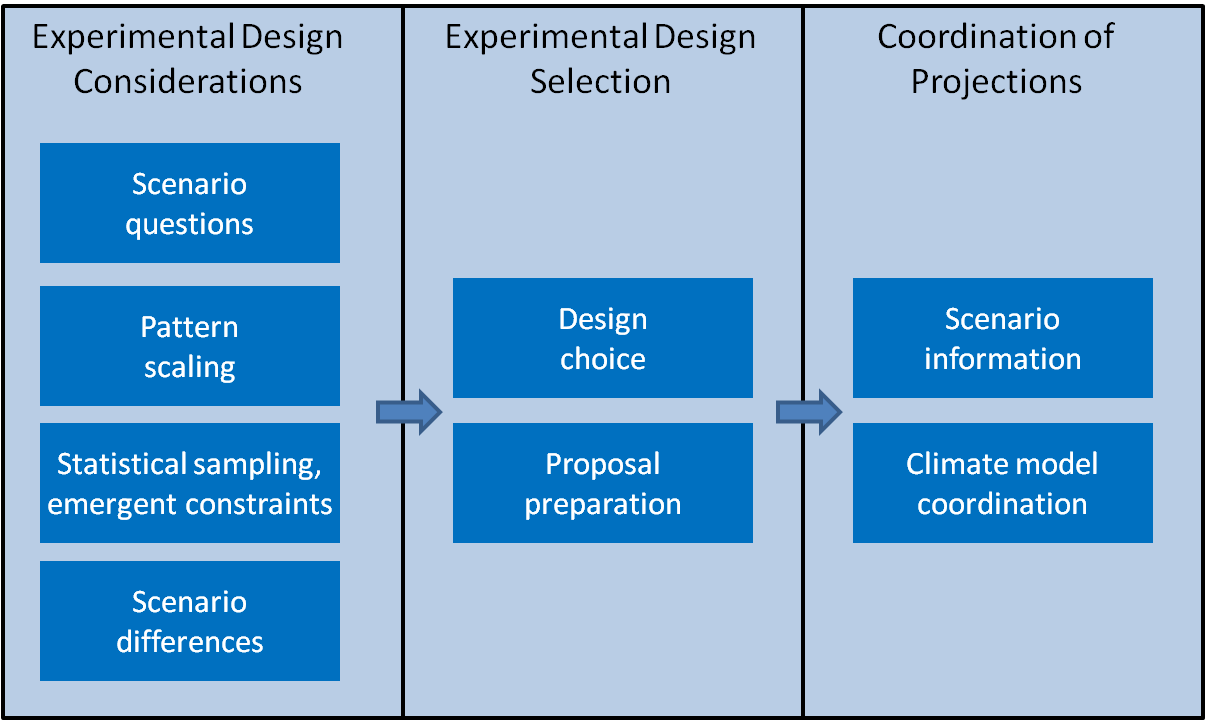Tasks
https://wcrp-cmip.org/model-intercomparison-projects-mips/scenariomip
Scenario Model Intercomparison Project (ScenarioMIP) activities have been organized into the three tasks below. Tasks 1 and 2 are complete as of September 2016, and Task 3 is ongoing.
Task 1
Experimental Design Considerations 2014
A ScenarioMIP Scientific Steering Committee was formed in late 2013 and subsequently investigated issues that could influence the experimental design of ScenarioMIP, including the possibility of statistically sampling climate model-scenario combinations, the potential for pattern scaling or other statistical emulators of climate model output to meet some of the demand for scenario-based climate information, and the differences between scenarios (in terms of global average forcing or temperature change) that is required to produce climate outcomes that are significantly different at the grid-cell level.
These investigations concluded that a sparse statistical sampling approach to design was unworkable, that pattern scaling has not yet been demonstrated to be able to reliably replace the need for climate model simulations to generate information for impact studies, though it might play a limited role for some applications (see the final report from the 2014 NCAR Meeting on Pattern Scaling, Climate Model Emulators and their Application to the New Scenario Process), and that scenario differences of at least 0.3 C in global average temperature are likely necessary to generate statistically significant differences in local temperature and precipitation outcomes over a substantial fraction of the surface (see Tebaldi et al, 2015, https://iopscience.iop.org/article/10.1088/1748-9326/10/7/074001)
Task 2
Experimental Design Selection 2014-2016
Informed by the conclusions from Task 1, the Scientific Steering Committee organized a process to develop the final protocol for ScenarioMIP, closely interacting with the climate research, integrated assessment modeling (IAM), and impacts, adaptation, and vulnerability (IAV) communities. The process included follow-up meetings in summer 2014, discussions with representatives of the Integrated Assessment Modeling Consortium (IAMC) Working Group on Scenarios producing candidate scenarios for CMIP6, and discussions with key individuals in other relevant research communities.
The ScenarioMIP proposal was endorsed by the CMIP panel on July 22, 2015. A paper based on this proposal and describing the protocol has been published in a Coupled Model Intercomparison Project Phase 6 (CMIP6) special issue of the journal Geoscientific Model Development.
Task 3
Coordination Of Climate Model Projections 2016-2020
ScenarioMIP has been working with the IAMC and the Land Use Model Intercomparison Projet (LUMIP) to coordinate the provision to climate modeling groups of emissions, concentrations, and land use information for these scenarios. It will also coordinate the production of climate model simulations, facilitate provision of output relevant to the impact/adaptation and integrated assessment communities, and analyze results.
If you are interested in subscribing to our google group please visit:
https://groups.google.com/a/ucar.edu/forum/?hl=en#!forum/scenariomip
